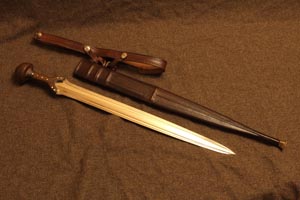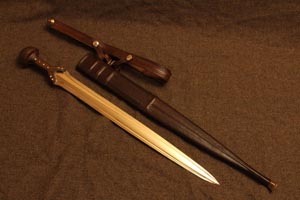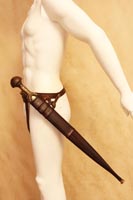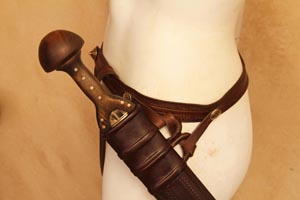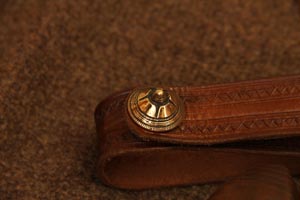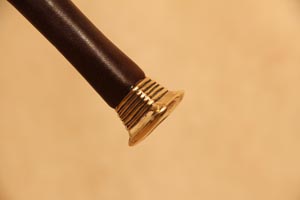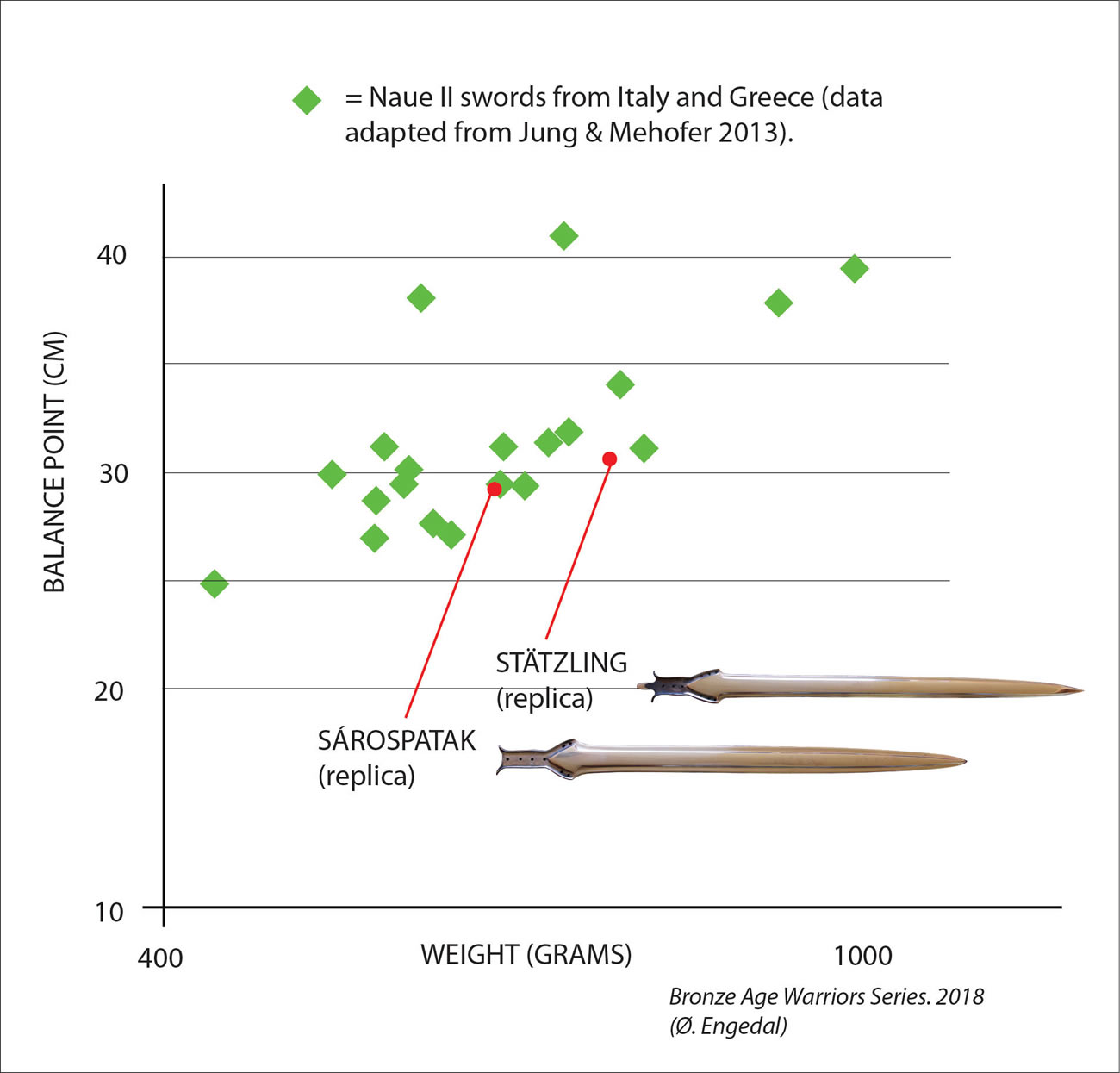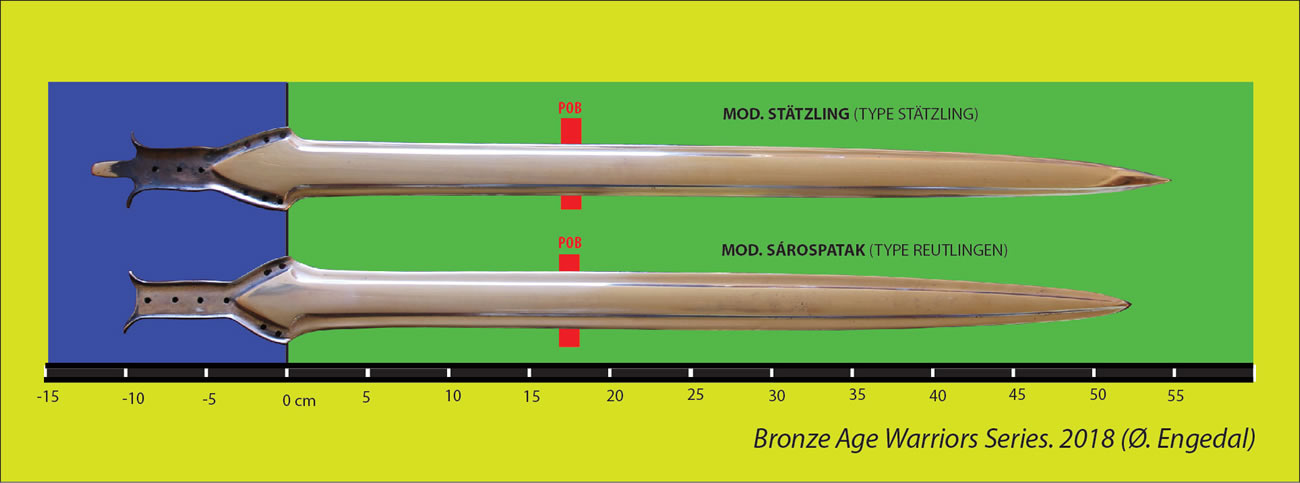SÁROSPATAK
Home > The Sword collection >Sárospatak
|
Replica of the sword from Sárospatak, HungaryWeight: c. 580 grams (bronze)- Length: 63 cm (excl. pommel) - Material: bronze (Cu90Sn12). Edge: hardened through cold hammering, ground - Original: Sárospatak, Hungary (Kemenczei 1988: n0 264). Scabbard and sword-belt sets available in three different versions: Naue II Nordic, Naue II Central European, and Naue II Aegean. Please contact info@warriorbronze.com for prices and options.
|
|
|---|---|
The Naue II Nordic versionThis set features a scabbard and suspension system based on well-preserved scabbards from Sweden and Denmark. Accessories:
A further option is tooling of scabbard and belt, with the "wolf-tooth"-pattern popular in this period. Such a pattern was tooled on the leather zip-bag from the Hvidegården burial. The Naue II Aegean versionThe Naue IIThe Naue II is a type of sword within the class of flange-hilted swords, and flange-hilted swords are a group within the large family of Griffzungenschwerter. • its wide geographical distribution, the first type to gain popularity both in Continental Europe and the Aegean.
The Naue II can be divided into two major sub-types: • An early type without pommel-tang, here called Reutlingen (known also as Catling I, Cetona, type A (Killian-Dirlmeier), typ Ci (Kemenczei), var. Alt Sammit-Pölitz (Wüstemann) or simply "fishtail"). These are the most common, the first numbering a total of 933 specimens (type Reutlingen). Only 190 swords are of the other sub-types (including type Stätzling). The origin of the type has been much debated, but in light of typo-chronological work in the last decades, the following seems clear: • the flanged hilt came several hundred years before the Naue II, both in Northern Europe, Central Europe and the Aegean. The origin of the flanged hilt is probably to be found in the Aegean, possibly on shorter blades in Anatolia and the Levant.
The original sword from Sárospatak, Hungary (Kemenczei 1988: n0 264)
Weight and BalanceThe two replica models of the NAUE II have been tuned to balance in accordance with original NAUE II swords. The diagram show the ratio of point of balance vs. weight of model Sárospatak and model Stätzling compared to original swords from Italy and Greece. This is of course measurements without hilt plates and pommel, in order to make a comparison with authentic Bronze Age swords.
Ratio of point of balance vs. weight of model Sárospatak and model Stätzling compared to original swords from Italy and Greece. Data on swords fro Italy and Greece adapted from Jung & Mehofer 2013. Thanks to Mr. Reinhard Jung and Mr. Mathias Mehofer for information on the methods used for measuring the original swords from Italy and Greece.
We should keep in mind that the above diagram only shows a small sample of the total number of Naue II swords, and the sample is from outside the major areas of production in Central- and Northern Europe. But there is no reason to doubt that this sample is representative: there is a main cluster on weights from 550 to 800 grams, with points of balance from 26cm to 34cm (measured from proximal end of sword, i.e. top of hilt).
Model Stätzling: Weight: 790 grams. POB: 29-31 cm. Total length: 67 cm (all measurements unhilted).
We should also allow for some noise related to the fact that the presence of a pommel tang or not (type Stätzling or Reutlingen) is not taken into consideration in these measurements. Measured from the hand, the two models are very similar (see figure below).
The two Naue II models compared.
Ltterature:Drews, R. 1993: The End of the Bronze Age. Changes in Warfare and the Catastrophe ca. 1200 B.C. Princeton University Press. Jung, R. 2008: Pirates of the Aegean: Italy - the East Aegean – Cyprus at the end of the Second Millennium BC. In: Karageorghis, V. & Kouka, O. 2009: Cyprus and the East Aegean. Intercultural Contacts from 3000 to 500 BC. An International Archaeological Symposium held at Pythagoreion, Samos, October 17th - 18th 2008. Nicosia. Jung, R. & Mehofer, M. 2013: Mycenaean Greece and Bronze Age Italy: Cooperation, Trade or War? Archäologisches Korrespondenzblatt 43. RGZM. Jung, R. & Mehofer, M. 2006: A Sword of Naue II Type from Ugarit and the Historical Significance of Italian-type Weaponry in the Eastern Mediterranean. Aegean Archaeology. Vol 8. Kemenczei, T. 1988: Die Schwerter in Ungarn I. Griffplatten-, Griffangel-, Griffzungenschwerter. Prahistorische Bronzefunde IV, 6. München. Kristiansen, K. & Suchowska-Ducke, P. 2015: Connected Histories: the Dynamics of Bronze Age Interaction and Trade 1500–1100 bc. Proceedings of the Prehistoric Society, 81, pp 361-392. Papst, S. 2013: Naue II-Schwerter mit Knaufzunge und die Aussenbeziehungen der mykenischen Kriegerelite in postpalatialer Zeit. Jahrbuch des Römisch-Germanischen Zentralmuseums 60: 105-152.
|
|
